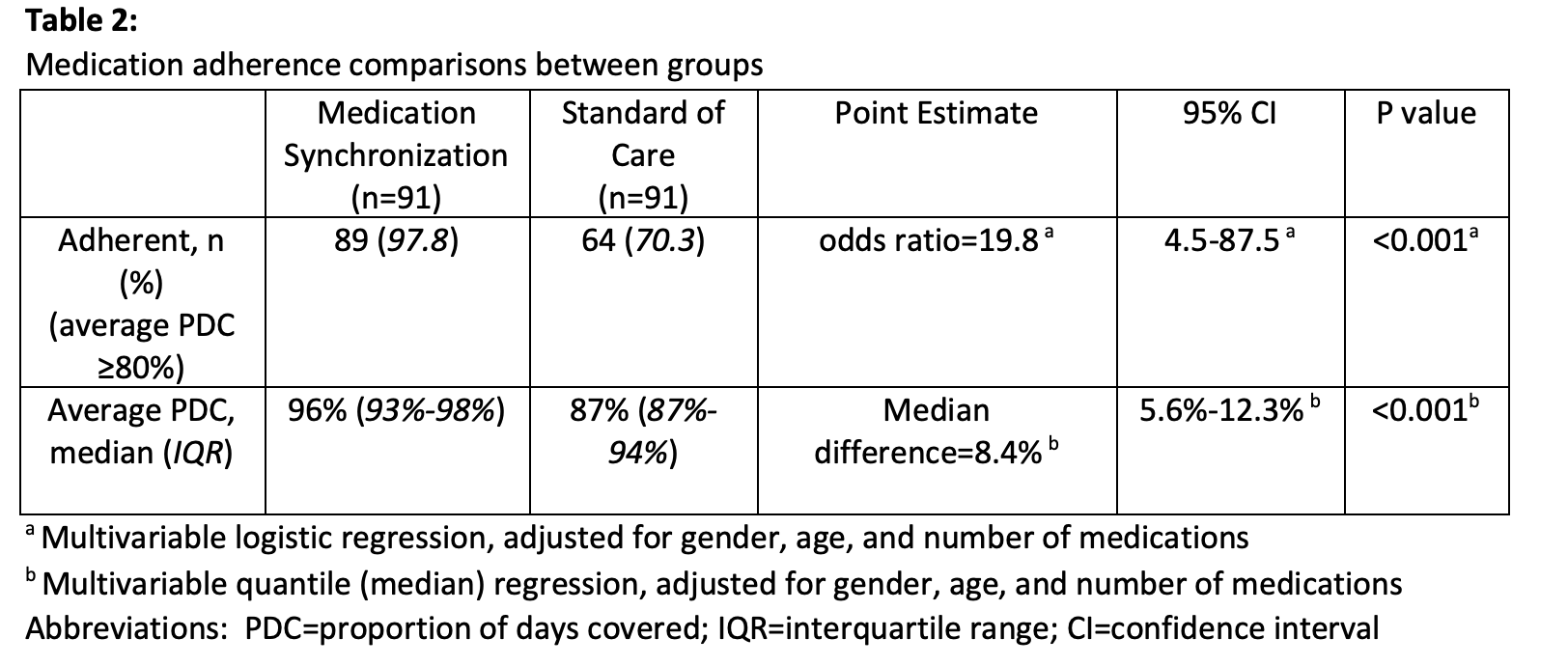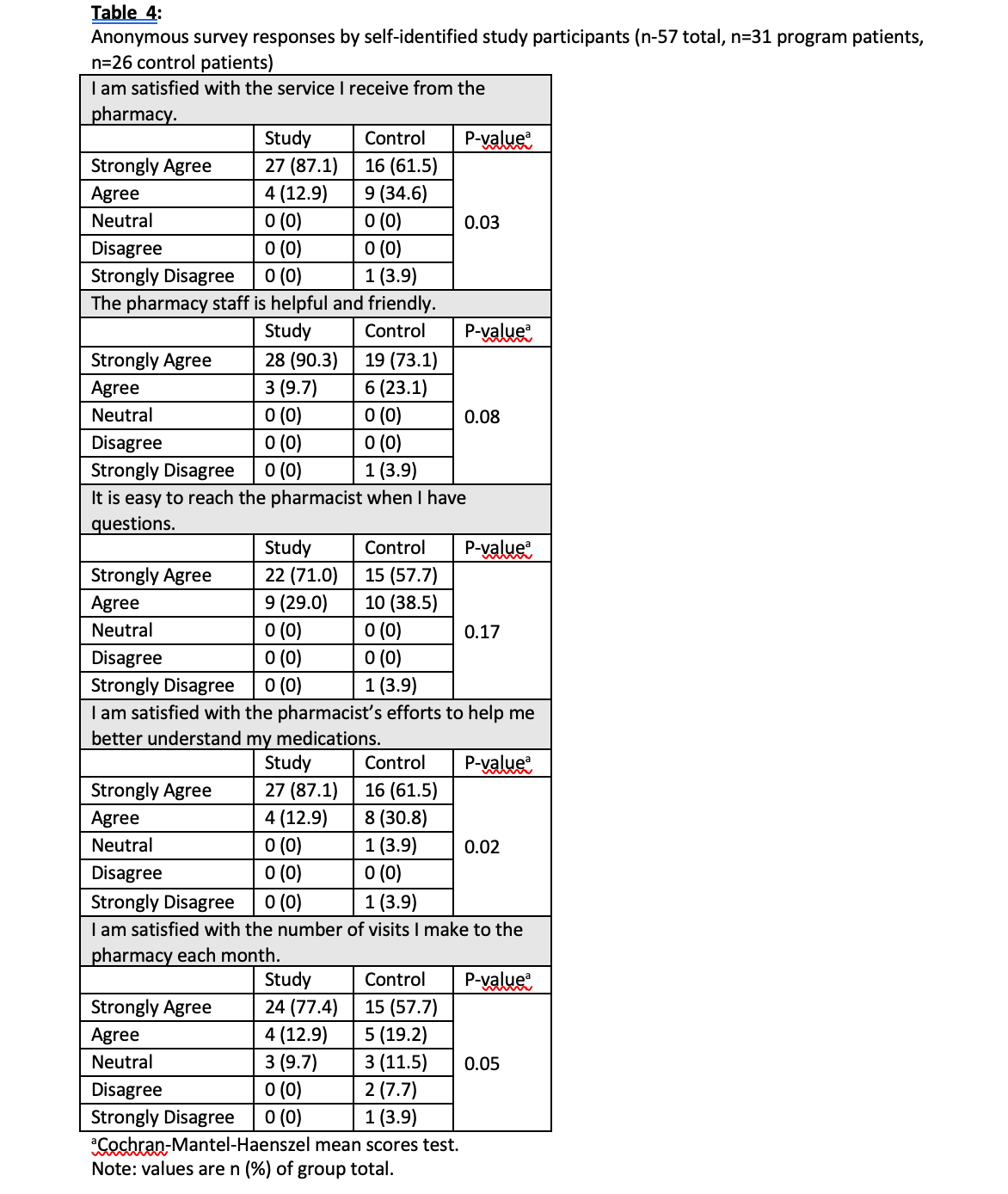Article
The Impact of a Medication Synchronization Program on Adherence and Patient Satisfaction
Author(s):
Studies have indicated that medication synchronization can have a positive impact on medication adherence, but few have assessed patient satisfaction with these programs.
Abstract
Background: Studies have indicated that medication synchronization can have a positive impact on medication adherence, but few have assessed patient satisfaction with these programs.
Methods: This retrospective study compared patients enrolled in a medication synchronization program with patients receiving the standard of care. Patients were followed from 3 to 18 months depending on their enrollment date. An anonymous patient satisfaction survey was mailed to all study participants at the end of the study period. The primary outcome was adherence, as defined as the average medication proportion of days covered (PDC) of 80% or greater. Secondary outcomes included the number of visits to the pharmacy per month and patient satisfaction.
Results: There were 182 patients included in the analysis, with 91 patients in the medication synchronization program and 91 patients who received the standard of care. In the medication synchronization program, 97.8% of patients were adherent, compared with 70.3% of patients in the control group (p<.001). The odds of adherence were 19.8 times greater in the medication synchronization group [OR=19.8; 95% CI (4.5 – 87.5); p<0.001]. The program resulted in 25% fewer visits to the pharmacy per month [incidence rate ratio=0.75, 95% CI (0.65 – 0.86); p<0.001]. Patients in the program were significantly more satisfied with the service they received from the pharmacy (p=0.03) and with the pharmacist’s counseling efforts (p=0.02).
Conclusion: A medication synchronization program within a health-system pharmacy resulted in improved adherence, fewer visits to the pharmacy, and greater patient satisfaction. These results add further evidence for the efficacy of community pharmacy-based medication synchronization programs in improving medication adherence.
Background
Medication nonadherence remains an unresolved public health issue in the United States and is a significant source of morbidity, mortality, and increased healthcare costs for patients with chronic disease states.1 Studies assessing adherence to chronic medications have reported an average adherence rate of 50%.2-6 Failure to adhere to prescribed medication regimens costs the US health care system more than $100 billion each year for otherwise avoidable hospitalizations.7
Though there are many different factors influencing medication nonadherence, an important aspect to consider is the complexity of a regimen. Complex medication regimens and frequent pharmacy visits have been associated with lower adherence rates in patients taking long-term medications.8 Medication synchronization can assist in simplifying these regimens by aligning all refills to fall on the same day every month.
Multiple studies have indicated that medication synchronization programs may improve adherence. A study involving a nation-wide pharmacy chain found that patients enrolled in a medication synchronization program had a 7.5% increase in adherence over 4 months, compared with a 2.8% increase for unenrolled patients.9 In a program in rural pharmacies, participants who were newly prescribed therapy with chronic medications had 3.4 to 6.1 greater odds of adherence than others.10 Patients in another program who were taking chronic medications for at least 6 months had 2.3 to 3.6 greater odds of adherence than patients receiving the standard of care.11
Though studies have shown benefits with medication synchronization, few have addressed patient satisfaction. One survey of patients enrolled in a medication synchronization program indicated they were highly satisfied with the service.12 Assessing patient satisfaction with medication synchronization may assist with marketing these programs to patients and providers alike.
Objective
The primary objective of this study was to determine the effect of the medication synchronization program on medication adherence. Secondary objectives included assessing the number of visits to the pharmacy per month and patient satisfaction.
Methods
Pharmacy fill data were obtained from 3 local health-system pharmacies from July 2017 through February 2019. Patients were included in the analysis if they were at least 18 years of age and received 3 or more prescriptions to treat chronic diseases.
Prescriptions written for as-needed use or a 90-day supply were excluded. Data were collected for 3 to 18 months, depending on when patients were enrolled in the program, and for 18 months for control patients.
The primary outcome was adherence, defined as an average medication proportion of days covered (PDC) of 80% or greater. The PDC for each medication was computed for each patient using the type 2 definition as in Chu, et al.13
The average PDC across all medications for each patient was computed and converted to a percentage. Secondary outcomes included the number of visits to the pharmacy per month and patient satisfaction, as determined by a survey.
The anonymous survey was mailed to all participants in March 2019 and included a stamped, self-addressed envelope for return. The number of visits to the pharmacy was calculated as the number of unique dispense dates during the study period.
Data Analysis
Baseline characteristics, the percentage of adherent patients, and the average PDC were compared between groups using Pearson’s chi-square test and the Wilcoxon rank-sum test. A logistic regression model was used to compare the odds of adherence between groups.
Adjusted group comparisons were made using a quantile (median) regression model for the average PDC and a Poisson regression model for the number of visits to the pharmacy per month. Lastly, survey responses were compared between groups using the Cochran-Mantel-Haenszel row mean scores test. A P value of <0.05 was considered statistically significant. The data analysis was conducted using SAS software, version 9.4 (SAS Institute Inc., Cary, NC).
Results
The analysis included 91 patients in the medication synchronization program and 91 patients who received the standard of care. The evaluation occurred between July 2017 to February 2019. The average length of follow-up for patients in the medication synchronization program was 175 days. Descriptive characteristics are presented in Table 1. There were no significant differences between the 2 groups.

The percentage of adherent patients was significantly greater for patients in the medication synchronization program than control patients (Table 2). In the medication synchronization group, 97.8% of patients were considered adherent, as compared with 70.3% of control patients (p<0.001).

In addition, the odds of adherence were 19.8 times greater in the medication synchronization group than the control group [odds ratio=19.8; 95% CI 4.5 – 87.5; p<0.001]. The median average PDC was 96% for the medication synchronization group, while 87% for patients receiving the standard of care (p<0.001). The adjusted median average PDC in the medication synchronization group was larger by 8% after [median difference=8.4%, 95% CI 5.6% – 12.3%); p<0.001].
The number of visits to the pharmacy per month was significantly lower in the medication synchronization program (Table 3). Patients in the program visited the pharmacy 1.4 times per month versus 1.8 times per month for patients receiving the standard of care. The adjusted rate of pharmacy visits was 25% lower in the medication synchronization group than the control group [incidence rate ratio=0.75, 95% CI 0.62 – 0.86; p<0.001].

Of 182 mailed surveys, 57 patients responded (Table 4). Patients in the medication synchronization program were significantly more satisfied with the service they received from the pharmacy (p=0.03) and with the pharmacist’s efforts to educate them (p=0.02). Program patients were highly satisfied and would recommend it to others but did not perceive an adherence benefit (Table 5).


Discussion
Both the percentage of adherent patients and the average adherence rate were significantly greater among patients enrolled in a medication synchronization program. Patients in both groups demonstrated slightly higher rates of adherence relative to other publications.
Previous studies have reported an average PDC or MPR of 73% to 91% for patients enrolled in these programs compared with a rate of 57% to 81% among control patients.9-11 It is unclear why a higher adherence rate was demonstrated in this study but could be due to the shorter study period, health-system specific factors, or geographical factors.
Patient satisfaction with medication synchronization has rarely been addressed. To our knowledge, this study is the first to compare patient satisfaction between patients enrolled in a medication synchronization program and those receiving the standard of care.
Patients in the program were significantly more satisfied with the service they received from the pharmacy and the pharmacist’s counseling efforts. Interestingly, patients did not perceive an adherence benefit nor were they more satisfied with the number of visits made to the pharmacy each month.
There are several limitations to this project. First, patients were followed for a relatively short period of time. In addition, the study was conducted at a local level and therefore, the results may not be generalizable. Furthermore, participation within the medication synchronization group for the survey was self-reported, and it was not possible to confirm this as the survey was anonymous.
This study adds further evidence for the efficacy of community pharmacy-based medication synchronization programs in improving medication adherence. In addition, this study is 1 of few that have addressed patient satisfaction with these programs and the first to compare patient satisfaction between patients in a medication synchronization program and those receiving the standard of care.
Authors
Amanda Schroeder, PharmD; PGY-1 Pharmacy Resident, Department of Pharmacy, Mayo Clinic Health System, Eau Claire, WI; John Folstad, PharmD; Pharmacist in Charge, Pharmacy & Home Medical, Mayo Clinic Health System, Eau Claire, WI; Michele Richmond, RPh; Director of Outpatient Pharmacy Services, Pharmacy & Home Medical, Mayo Clinic Health System, Eau Claire, WI; Joe Stearly, MHA; Health Systems Engineer, Management Engineering & Internal Consulting, Mayo Clinic Health System, Eau Claire, WI; Richard Arndt, PharmD, BCPS; Senior Manager, Pharmacy Clinical Practice, PGY-1 Pharmacy Residency Program Director, Department of Pharmacy, Mayo Clinic Health System, Eau Claire, WI; Ross Dierkhising, MS; Biostatistician, Division of Biomedical Statistics and Informatics, Mayo Clinic, Rochester, MN; Jordan Dow, PharmD, MS, FACHE; Regional Director of Pharmacy, Mayo Clinic Health System, Eau Claire, WI.
REFERENCES
- World Health Organization. Adherence to long-term therapies: evidence for action. Geneva: World Health Organization; 2003.
- Lee JK, Grace KA, Taylor AJ. Effect of a pharmacy care program on medication adherence and persistence, blood pressure, and low-density lipoprotein cholesterol: a randomized controlled trial. JAMA. 2006;296(21):2563–2571.
- Benner JS, Glynn RJ, Mogun H, Neumann PJ, Weinstein MC, Avorn J. Long-term persistence in use of statin therapy in elderly patients. JAMA. 2002;288(4):455-61.
- Cramer JA, Benedict A, Muszbek N, Keskinaslan A, Khan ZM. The significance of compliance and persistence in the treatment of diabetes, hypertension and dyslipidaemia: a review. Int J Clin Pract. 2008;62(1):76-87.
- Avorn J, Monette J, Lacour A, Bohn RL, Monane M, Mogun H, LeLorier J. Persistence of use of lipid-lowering medications: a cross-national study. JAMA. 1998;279(18):1458-62.
- Briesacher BA, Andrade SE, Fouayzi H, Chan KA. Comparison of drug adherence rates among patients with seven different medical conditions. Pharmacotherapy. 2008;28(4):437-43.
- Osterberg L, Blaschke T. Adherence to medication. NEJM. 2005;353(5):487–497.
- Choudhry NK, Fischer MA, Avorn J, Liberman JN, Schneeweiss S, Pakes J, Brennan TA, Shrank WH. The implications of therapeutic complexity on adherence to cardiovascular medications. Arch Intern Med. 2011;171:814-822.
- Girdish C, Shrank W, Freytag S, Chen D, Gebhard D, Bunton A, Choudhry N, Polinski J. The impact of a retail prescription synchronization program on medication adherence. JAPhA. 2017;57:579-584.
- Holdford DA, Inocencio TJ.Adherence and persistence associated with an appointment-based medication synchronization program. JAPhA. 2013;53:576-583.
Newsletter
Stay informed on drug updates, treatment guidelines, and pharmacy practice trends—subscribe to Pharmacy Times for weekly clinical insights.





